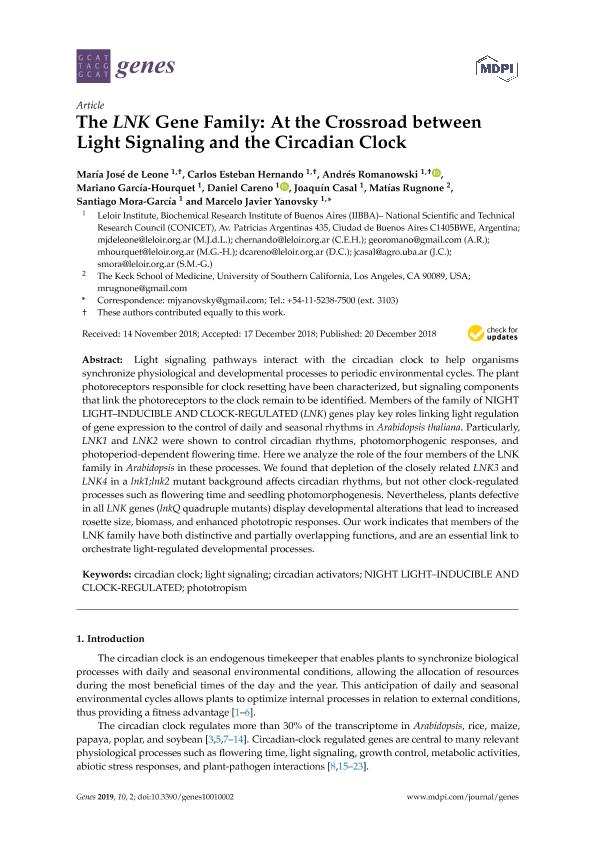Artículo
The LNK gene family: At the crossroad between light signaling and the circadian clock
de Leone, María José ; Hernando, Carlos Esteban
; Hernando, Carlos Esteban ; Romanowski, Andrés
; Romanowski, Andrés ; García Hourquet, Mariano; Careno, Daniel Alejandro
; García Hourquet, Mariano; Careno, Daniel Alejandro ; Casal, Joaquín; Rugnone, Matias Leandro
; Casal, Joaquín; Rugnone, Matias Leandro ; Mora Garcia, Santiago
; Mora Garcia, Santiago ; Yanovsky, Marcelo Javier
; Yanovsky, Marcelo Javier
 ; Hernando, Carlos Esteban
; Hernando, Carlos Esteban ; Romanowski, Andrés
; Romanowski, Andrés ; García Hourquet, Mariano; Careno, Daniel Alejandro
; García Hourquet, Mariano; Careno, Daniel Alejandro ; Casal, Joaquín; Rugnone, Matias Leandro
; Casal, Joaquín; Rugnone, Matias Leandro ; Mora Garcia, Santiago
; Mora Garcia, Santiago ; Yanovsky, Marcelo Javier
; Yanovsky, Marcelo Javier
Fecha de publicación:
01/2019
Editorial:
Molecular Diversity Preservation International
Revista:
Genes
ISSN:
2073-4425
Idioma:
Inglés
Tipo de recurso:
Artículo publicado
Clasificación temática:
Resumen
Light signaling pathways interact with the circadian clock to help organisms synchronize physiological and developmental processes to periodic environmental cycles. The plant photoreceptors responsible for clock resetting have been characterized, but signaling components that link the photoreceptors to the clock remain to be identified. Members of the family of NIGHT LIGHT–INDUCIBLE AND CLOCK-REGULATED (LNK) genes play key roles linking light regulation of gene expression to the control of daily and seasonal rhythms in Arabidopsis thaliana. Particularly, LNK1 and LNK2 were shown to control circadian rhythms, photomorphogenic responses, and photoperiod-dependent flowering time. Here we analyze the role of the four members of the LNK family in Arabidopsis in these processes. We found that depletion of the closely related LNK3 and LNK4 in a lnk1;lnk2 mutant background affects circadian rhythms, but not other clock-regulated processes such as flowering time and seedling photomorphogenesis. Nevertheless, plants defective in all LNK genes (lnkQ quadruple mutants) display developmental alterations that lead to increased rosette size, biomass, and enhanced phototropic responses. Our work indicates that members of the LNK family have both distinctive and partially overlapping functions, and are an essential link to orchestrate light-regulated developmental processes.
Archivos asociados
Licencia
Identificadores
Colecciones
Articulos(IIBBA)
Articulos de INST.DE INVEST.BIOQUIMICAS DE BS.AS(I)
Articulos de INST.DE INVEST.BIOQUIMICAS DE BS.AS(I)
Citación
de Leone, María José; Hernando, Carlos Esteban; Romanowski, Andrés; García Hourquet, Mariano; Careno, Daniel Alejandro; et al.; The LNK gene family: At the crossroad between light signaling and the circadian clock; Molecular Diversity Preservation International; Genes; 10; 1-2019; 1-18
Compartir
Altmétricas



